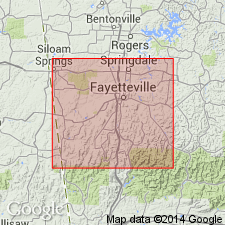
- Usage in publication:
-
- Wyman sandstone
- Modifications:
-
- Named
- Dominant lithology:
-
- Sandstone
- AAPG geologic province:
-
- Arkoma basin
Summary:
Wyman sandstone. Exposed in Washington County, Arkansas, in the Arkoma basin. Extends along banks of the White River, 4.5 miles east of Fayetteville. Also occurs in vicinity of Wyman schoolhouse. Consists of a rather soft sandstone which, when weathered, is a yellowish brown color but where freshly broken is a much lighter color. Frequently forms a layer 2 to 3 feet thick; these layers are very noticeable on the banks of White River, near section corner between secs. 8, 9, 16, and 17, T. 16 N., R. 29 W., along southern bank of West Fork in the same township, and on northern bank of White River, in secs. 3, 4, 8 and 9. In many localities, the Wyman sandstone separates the Boone chert and cherty limestone (new) below, from the Fayetteville shale (new) above. Measured well sections; sections measured range from 21 to 32 feet thick. [Not specifically identified in measured sections, but Wyman probably limited to sandstone lithology that is 3 to 10 feet thick.] Age is Early Carboniferous. Report includes geologic map of Washington County, stratigraphic table, columnar sections.
Type locality not designated. Named from Wyman, a station in Washington Co., AR, on the Pacific and Great Eastern RR.
Source: Modified from GNU records (USGS DDS-6; Denver GNULEX).
For more information, please contact Nancy Stamm, Geologic Names Committee Secretary.
Asterisk (*) indicates published by U.S. Geological Survey authors.
"No current usage" (†) implies that a name has been abandoned or has fallen into disuse. Former usage and, if known, replacement name given in parentheses ( ).
Slash (/) indicates name conflicts with nomenclatural guidelines (CSN, 1933; ACSN, 1961, 1970; NACSN, 1983, 2005, 2021). May be explained within brackets ([ ]).

